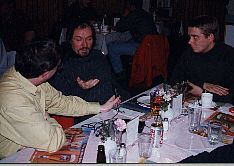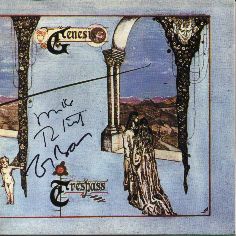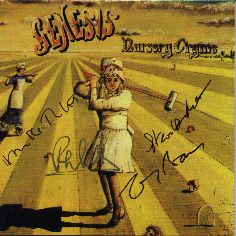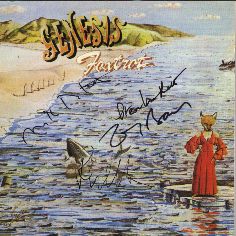"A View From Mount Fabmore" - Interview with Paul Whitehead at Le Croissant
du Port restaurant, Montreal, 14th November, 1998. Interview by Alan
Hewitt and Thomas Holter.
TWR: A lot of people have asked; 'what does Paul Whitehead do now?'
But let's start at the beginning - how did you meet Genesis?
| PW: Through John Anthony (the producer of Trespass) and I
was the artistic director for a magazine called "Time Out" which is a
sort of 'What's On' in London sort of magazine; very visible you know
and tuned in to everything that is going on, and I met John Anthony and
he saw my work and said; 'I'm producing this band; and you are a natural;
a perfect fit'. And the first time I met them, I went to the office -
the Charisma office and it was like; you have got to understand with the
English Class structure; English Public School boys are twits (laughter)
and these guys seemed very naïve and like; 'Oh, what a good wheeze;
we'll form a band and go on the road...' right? And they were very naïve.
The only guy that was kind of real was Mike really, he was the most real
guy to talk to, and basically I had an interview with them; they interviewed
me and I had no idea what they did. I think they gave me a copy of "From
Genesis To Revelation" to listen to and I didn't like it... So something
I said, they figured that I was their kind of guy and... (Here Armando
Gallo corrects Paul)
AG: Peter Hammill introduced Genesis to you...
PW: So, he introduced me to John Anthony then because he was
producing Van Der Graaf Generator... |
 Paul with Alan and Thomas
Paul with Alan and Thomas |
AG: Paul went to see a show with Van Der Graaf and John Anthony was
there and he got you the interview with Genesis I just remembered that...
PW: He remembers it better than I do! (laughter)..And it was kind
of weird; remember they went on the road with a picnic hamper, and they were
just not Rock & Roll at all you know. They didn't trust the food in the
transport cafes; you know, they took their own food and that was it. I spent
time with them and listened while they wrote the songs and gave them my feedback,
and brought books for them to look at and to me it was like they had the musical
language and I had the visual language - I knew things they didn't about visuals
and artists and stuff, and it worked.
| TWR: The ideas for, in particular, the "Trespass" cover; was
that a collaboration between the musical and the visual?
PW: Yeah, they gave me the songs right? And I am trying to remember
how we did it. I went away and listened to the songs and came back full
of ideas; we could do this; or we could do that and at the time I was
very into pen and ink drawings; a lot of pen and ink drawings. And I said;
'You know we could do a real romantic, almost like a Renaissance type
thing, with pen and ink...' and they said; 'like what?' and I had a book
of one of my favourite artists at the time which was a guy called William
Pagaunay, and I said; 'like this...' and they said; 'Ok' So then the question
was, how do you make it relevant to "The Knife"? And my reply was; 'well,
you slash the canvas' and they thought I was joking, and I finished the
painting; brought it in and said; 'Now we're going to slash it' and they
said; 'You're not going to slash it?' and I said; 'Yeah' and I just did
one ssht with the razor blade... actually I rented a knife from
a prop house and got a Renaissance like dagger and stuck it in and that
was it...
TWR: Obviously you then went on to do the next two covers for
the next two albums, and got more involved and once again, was it a case
of listening to the music and getting inspiration or did you already have
the ideas you wanted to get across? |
 Paul's artwork for "Trespass"
Paul's artwork for "Trespass" |
PW: Yeah, I lived with them down at the house where they were writing
the songs and got up in the morning and had breakfast with them and heard what
they were talking about and so I was like a sixth member in a way, in the creative
process. I knew what was on their minds; knew what they were trying to say and
it just evolved. It evolved as the songs evolved; and as I got the feel of what
they were trying to do. I think that once the decision was made it was going
to be around the Musical Box, then we just went...'OK, Victorian' and that gives
you a great period to work with, and once again I brought down a whole bunch
of books with me and it was a Dali painting that decided it was going to be
the false perspective, and the greenish colour; you know.
TWR: There is the classic story that when you varnished it; the bluebottles
on it are actually real...?
| PW: Yeah, I lived in Norfolk when I painted that and then
I decided that I wanted to brown the whole thing up a bot and so I varnished
it with some Marine varnish - the stuff they varnish boats with which
is very dark like brownish almost like treacle. And so, I took it outside
and put it on a chair and I never thought about the insects; and there
were flies and earwigs on it and I just thought; 'hey, leave it' and it
kind of adds to it. I think also, as an artist, I like that kind of thing
which is one of those kind of happy accidents where you have a certain
amount of control and then fate kind of takes over and kind of does other
things. A lot of artists try and stop those kind of things happening but
I like those kind of things...
TWR: So, you did those covers, and obviously since then you
have been working on a variety of projects; who else have you done work
for?
PW: Oh boy... It has been varied. I mean, I've done stuff for
people like Fats Domino; Creedence Clearwater Revival, and a lot of English
stuff like Renaissance and The Yardbirds and stuff like that. I get all
kinds of people coming to me and asking me to do a cover. There's a band
in Los Angeles called Operator who are a really Punky, nasty sort of band
but there's something about them which I respond to. They've got a feedback
guitarist who is really good.
TWR: But your collaboration with the band ended with Foxtrot...
why?
PW: Basically because I moved to the States; I moved to Los
Angeles and in those days that was a huge distance and I think there was
also a kind of feeling 'Oh, he's abandoned us' (laughter) 'he's gone to
America' and I just felt that was it; I'd done my bit although it probably
would have been nice to have done "Selling England By The Pound"... that
could have been a nice image...
TWR: I think the Betty Swanwick image is in the same spirit
in a way... |
 Paul's artwork for "Nursery Cryme"
Paul's artwork for "Nursery Cryme" |
PW: Yeah, I remember when I first saw it; I thought 'Yeah, that's really
appropriate, that's really nice...' But in those days it was a long distance
and we didnít have e-mail and it was a big deal telephoning and I think it would
have been difficult to do a record cover long distance.
TWR: You could do the cover to the next Genesis album...?
PW: If there is a next one! (laughter) yeah. I have just started work
on an image called "Requiem" looking back on all the people who were in the
band, and all the stages of Genesis, and if you go on the Internet there is
a painting on there called "No Scrumping" made up of islands floating in space
and I am going to do an image like that with maybe five or six floating islands
that will have the various stages of Genesis from the small one to the baseball
stadium, you know? (laughter).
TWR: And now you have decided to recreate those early covers in this
new format; tell us a little bit about that...?
PW: For me it has always been difficult to do the reproduction of
images because if you lithograph, you have to make thousands and thousands of
them, and in the process if making an image, there's a part of the process when
invariably you lose something when you convert an image to the lithography process,
you lose something. Well, now we have something on computer technology and this
basically uses the nearest original transparency I could get, which I got from
Virgin and scan and colour corrected it to the best of my memory using the printed
cover from the record company and how I remembered the painting and now we are
doing what is called Iris Prints, which is a 3200DPI dot matrix spray printer
which has no screen on the image. It is a continuous tone so it is as close
as you can get. The other great thing is; there's two advantages: you can print
ones and twos but you can also print on any material; paper; vinyl an dthere
is a guy who comes to the place where I have my prints made who prints on velvet,
so I am doing mine on canvas, because the original images were on canvas and
so the finished result is as close as you could possibly get, and I am amazed.
The added advantage is that the original image was taken from a canvas so it
has the texture and it is printed on canvas so...
| TWR: Are these available now or are they going to be available
soon...?
PW: They are available now. The lithographs... I am still colour
correcting them, and they will probably be available in about two weeks
and with those I do ones and twos as people order them, and it is great
- it is exactly what the original was.
TWR: Will they be available through your own Internet site?
PW: I have my own Internet site which is: paulwhitehead.com.
O am working with two guys from Nevada who have done a great job and I
have been looking back into my own archives, and I always had very good
transparencies made before they left my sight so, there are a lot of images
where people commissioned the painting; I delivered them and they were
never seen again. So, I have got back and hooked up my top ten favourite
images, you know; they are available as well.
TWR: What are they, apart from the Genesis ones...? |
 Paul's artwork for "Foxtrot"
Paul's artwork for "Foxtrot" |
PW: Well, I did a series of Astrological signs - I did the twelve astrological
signs, so that's on the web site now, that's the first show that we are having
in what we call the "Main Gallery" and every six months or so, it is an ongoing
changing show in there, and another part of the site is what I call my musical
images which are images used for record sleeves, and that is where the new stuff
is that you have never seen before. I did the cover for Tom Fogerty from Creedence
Clearwater Revival which was a great image which was never seen. I mean, he
didn't sell a lot of copies of that album; but it was always one of my favourite
images. It's funny because I have done something like 160 covers and Genesis
were like; my first; after that I did van Der Graaf Generator and all the Charisma
bands, and I was always baffled why those three covers were pebing persistently
asked about and I guess that now I look back on them and think: 'Yeah, they
were good' and it was a pretty unique relationship to say; 'OK; here's the guy
who is going to do your cover; we're going to send him down to stay with you
while you create...' and that is pretty unique. It was only them and Van Der
Graaf Generator that I had that kind of relationship with, where you are kind
of the "Gun For Hire" and I think it shows that that process works...
And there you have it; a unique insight into a unique artist, and a unique
band. Our thanks to the following people for making this interview, and the
one with Armando Gallo, possible: first of all to our host; Mr Jack Beermann
for his inestimable hospitality and incredible generosity. To Serge Morissette
and the guys in "The Musical Box" without whom there wouldn't have been a reason
to be in Montreal in the first place, and to everyone else who contributed -
you know who you are, folks and THANK YOU!!!



